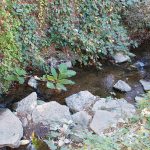
The Dumbarton Rail Corridor (pictured here at the intersection of Willow Road in Menlo Park) is being considered for a possible segment of the planned 40-mile Bay to Sea Trail. Photo courtesy POST.
You have likely heard of the popular High Line park in the City of New York. Perhaps you have even visited this rails-to-trails park with its garden walks, world-class eateries, and art installations that was converted from an elevated freight line screaming above the streets of New York to a bustling public open space.
Here in the Bay Area, we have our own versions of rails-to-trails parks, some of which have been in use for years and others that are in the planning stages.
“Rails-to-trails projects are really fantastic because these often-abandoned sections of railroad land are narrow, long, and linear and lend themselves to potential open space,” said Amy Wooldridge, the recreation and parks director for the City of Alameda. “They also tend to be valuable because railroads were connection points that moved freight or people, so they create greenbelt areas that people can use to connect from one part of the city to another in a safe, protected, and fun way.”
The Jean Sweeney Open Space Park in Alameda is a case in point. The first phase of what will be a 25-acre park opened in December 2018. Phase one includes a playground in the eastern portion of the park and the Cross Alameda Trail, which will eventually span the entire island of Alameda from east to west.
The inception of this park traces back to Jean Sweeney, a teacher and community activist, who in 1998 envisioned an open space park to replace the abandoned Alameda Belt Line railyard and rail line between Sherman Street and Constitution Way. The landowner had plans to sell the land for $20 million to a developer for 200 homes, but Sweeney gathered signatures and enthusiasm to pass an initiative to rezone the land as open space.
While researching historic files, Sweeney found the original 1924 contract that granted the city the option to repurchase the land if the rail line was ever decommissioned, which it had been since 1939. She turned her findings over to the city, and after years of litigation, the city won on appeal and was able to purchase the land for just under $1 million.
Sweeney took an active role in turning the right-of-way into a park, but it took a village to make it happen. “This park wouldn’t have happened without community advocates. It most likely would have been housing at this point without her galvanizing the community,” said Wooldridge.
The Jean Sweeney Open Space Park is just one example of a rails-to-trails park in the Bay Area. Other examples include the Old Railroad Grade on the eastern side of Mount Tamalpais that follows the route of the Mt. Tamalpais and Muir Woods Scenic Railroad, the seven-mile-long Linear Park in Fairfield that lopes atop an old Northern Electric Company passenger rail right-of-way, and the granddaddy of them all, the Iron Horse Regional Trail that stretches from Concord to Pleasanton.
“The Iron Horse Trail is the spine through the inner valleys,” said Beverly Lane, an East Bay Regional Park District (EBRPD) board member who was active from the start with the Right-of-Way Trail Advocates, a citizen advocacy group from Alamo, Danville, and San Ramon. They envisioned a trail like the Lafayette-Moraga Regional Trail, the first rails-to-trails project of EBRPD, and one of the first rails-to-trails projects in California.
The history of the Iron Horse Regional Trail right-of-way reaches back to 1891 when the Southern Pacific Railroad Company built a line from San Ramon to the Suisun Bay west of Port Chicago to transport farm goods. The trains lost momentum as automobiles and trucks filled the roadways, and the last train ran in 1978. The railroad removed the tracks the following year.
“There was a mad scramble to not sell it off in pieces,” said EBRPD’s general manager Robert Doyle, who, as the district’s trail coordinator at the time, was exploring the new concept of a regional trail system to connect parks. EBRPD’s regional trail system is now one of the largest in the U.S.
“There certainly was an intent to look at putting light rail there, but a study concluded that it just wasn’t feasible with 35 street crossings,” said Doyle.
“Readers should know it wasn’t a finger-snap, ‘Let’s do this.’ It was done piecemeal,” he added. The first pieces were done in Walnut Creek. Then came sections in Danville, Concord, Pleasant Hill, and San Ramon, in that order. “Now we go all the way into Pleasanton,” Doyle said.
The trail, managed by EBRPD and used by 1.3 million people annually, isn’t just for recreation. To assess usage, EBRPD used a federal grant to install counters at intersections of the regional trail system (including Iron Horse), and the data showed that peak use of the trails aligned with peak use on highways.
“It’s a green transportation system that gets to parks and everywhere else,” Doyle said. “We calculated that there are 40 schools within one-half mile of the Iron Horse Trail. It connects to everything and that’s why it’s so popular.”
While all abandoned railroad right-of-way corridors may not be appropriate for reintroducing train service, there is one defunct right-of-way in the Bay Area that is being considered for both a new passenger rail line and a trail. Still in the visionary phase, the western leg of the Dumbarton Rail Corridor is seen as being a possible segment of the Bay to Sea Trail, a planned 40-mile multi-use trail that would connect the San Francisco Bay to the Pacific Ocean. The project is picking up steam and eleven partners and agencies are working together to find a route, said Rachael Faye at the Peninsula Open Space Trust (POST). “The trail will be the first and only east-to-west trail in the Peninsula that connects to the sea,” said Faye. “It will connect four regional trails and create regional connectivity.”
The rails-to-trails segment of the Bay to Sea Trail would run along the Dumbarton right-of-way from Ravenswood Open Space Preserve in East Palo Alto to Bair Island in Redwood City, while another segment would lead over to Half Moon Bay. The San Mateo County Transit District and the Cross Bay Transit Partners (a partnership of tech titan Facebook and infrastructure developer Plenary Group) are conducting a feasibility study for a public/private passenger rail line on the old Dumbarton line, which includes reconstructing its inactive rail bridge to connect the Peninsula with the East Bay.
“POST is not taking a position on rapid transit improvements being proposed by the Cross Bay Transit Partners, but we are taking a position to support active transit improvements for walking and biking,” said Faye. “A trail on the Dumbarton Rail Corridor would be positive and beneficial to our community. There’s room for a rail line and a trail.”
If you have walked the San Francisco Bay Trail or visited bayside open space parks in the Peninsula, you know you have to drive on highways, cross overpasses, and skirt industrial and urban infrastructure to get there. A trail on the Dumbarton Corridor would help connect the urban community with existing open spaces.
“The trail would pass through communities that have the most limited access to safe, active transportation that connects people to destinations. This trail would provide connectivity that is an enjoyable experience,” said Faye.
“Transportation costs are the second-biggest drain on household budgets, so creating affordable mobility options is critical for lower-income families,” said Laura Cohen, director of Rails-to-Trails Conservancy’s western region. “Trails are part of the solution for those who don’t or can’t drive due to the high costs of car ownership, age, or disability.”
Most trails and parks take time and community advocacy to bring them to fruition, and sometimes, those who work on the projects don’t live to see the results. Jean Sweeney died seven years before the park named in her honor was opened, but during her lifetime she remained undeterred in putting in the necessary work and time for the future benefit of other residents. Clearly, she lived by the words of the old Greek proverb, “A society grows great when old men” — and, of course, women — “plant trees whose shade they know they shall never sit in.”
Aleta George loves trails and trains. She is the proud granddaughter of L.E. Brown, Sr., an engineer for the Southern Railway’s 1401, now the largest train on display in the Smithsonian’s National Museum of History.

